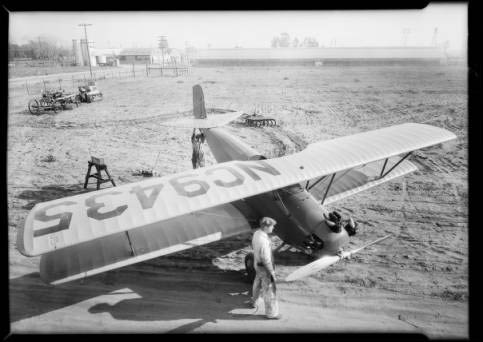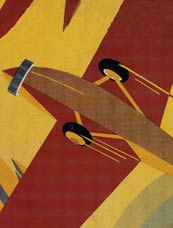|
A SHORT, HARD LIFE
This airplane is a Fleet Model 2, S/N 83 (ATC #131). It
was manufactured on June 7, 1929 by Fleet Aircraft, Inc.,
Buffalo, NY. It left the factory with a Kinner K-5 engine
of 90HP (S/N 367). It was a two-place airplane of 1,575 pounds
gross weight.
It sold to W.B. Kinner of Glendale, CA on June 7, 1929,
the same day it was completed. It was transferred to the
Kinner Airplane & Motor Corporation of Glendale on June
21, 1929.
According to the NASM record, the airplane had accumulated
40 flight hours by June 27, 1929. This would probably account
for the ferry time from New York to California, plus a few
more. The record says that the original engine was replaced
by a Kinner K-5 S/N 465. as of June 27. Forty hours on an
engine isn't much time. Perhaps the pilot who flew it west
mismanaged it, and caused it to fail early. Or Kinner chose to use it to test his engines.
Likewise, on November 15, 1929 the record says the airplane
was overhauled and re-covered with fabric at the factory,
and another Kinner K-5 (S/N 900) was installed.
NC9435 landed at Tucson three times, December 7, 1929, April
17, 1930 and Saturday, May 24, 1930 . It was based at Los Angeles, CA at each of these visits.
The first landing was by pilot M.W. Jorenby. He was solo
westbound from El Paso, TX back to Glendale. He (or she) may
have been flying the airplane back from New York after the
November factory maintenance. Below, from the University of Southern California Library (USCL) is a photograph of NC9435 taken during 1930 in Southern California (probably Glendale). Five photographs are at the link, plus two images of paperwork supplied by the photographer. The photographer identified the shots as, "Fleet plane at Kinner hangar." He didn't record an exact date. Please direct your browser to the link to view these photographs. They are made available by the Library as high-resolution digital images that may be magnified and explored in detail. For example, the machinery at left rear is a vintage land grader towed by a small bulldozer. Thanks to Guest Editor Bob Woodling for calling my attention to these excellent photographs.
Fleet NC9435, California, 1930 (Source: USCL via Woodling)
 |
The second landing at Tucson by NC9435 was by pilot Van
Murray. He was solo that spring, westbound from New York
to Glendale. A month later, on May 22, 1930, the airplane
sold to Central American Aviation Corporation, Ltd. It had
yet a fourth K-5 engine installed (S/N 1074).
This brings us to the third landing at Tucson May 24, 1930. NC9435 was being ferried in a flight of three to Guatemala. Daniel E. Ellis was the solo pilot. He arrived at Tucson a day after his two partners (cited below).
Site visitor John Lyon points out the following. In 1929 Ellis was chief pilot for Compañia Nacional de Aviación (CNA) of Guatemala, a fledgling airline founded by W.W. Hodkinson, who revolutionized motion picture distribution and founded Paramount Pictures. Ellis flew several airplanes to Guatemala City, one of which was Fleet NC9435. His flight through Tucson and beyond is documented in a Web-based article at the link. The title of the article is, "The Development of Domestic Airmail Services in Guatemala." Below, from page 4 of the article, is the part relevant to our flight of three.
"Local newspaper El Tiempo reported that on Thursday, 29 May 1930 at 10:50hr three civil airplanes of the Compañia Nacional de Aviación (CNA, National Aviation Company) arrived at La Aurora Airport, Guatemala City. [They were]:
(i) Hodkinson trimotor biplane, register NC-82-M, piloted by Capt. Harold White.
(ii) Fleet biplane of sport size, register NC-9435, piloted by Capt. Daniel Ellis.
(iii) Travel Air biplane of the Union Oil Co., USA, piloted by Capt. Harding.
"CNA was a private company formed by two Americans, William W. Hodkinson, founder of Paramount Pictures and Roderick Burnham, son of Frederick Russell Burnham, the “King of Scouts”. The Hodkinson trimotor airplane, built in California by the Hodkinson Aircraft Corporation, has an upper wing spread of 56' and a lower wing spread of 30' 6". The length of the fuselage from nose to tail is 30' 3". It has an empty weight of 2,200 lbs. with a maximum carrying capacity of 7,000 lbs. It has three Curtiss Challenger engines of 170 horsepower each. It has capacity for two pilots, six passengers and 300 lbs. of baggage or mail.
"The planes took 32 hours from California to Guatemala, principally because the two smaller planes that accompanied the trimotor have a small fuel capacity and had to refuel frequently." |
The article also exhibits photographs of the three aircraft. Ellis and Harding performed survey flights, as cited in the following section of the same Web article (page 4).
| "El Tiempo reported that on Tuesday, 3 June 1930 at 6.00hr the Fleet NC-9435, piloted by Capt. Daniel Ellis and accompanied by Mr. Alejos, departed on inspection flights to air fields in the departments in the west near the Mexico border. Also the Travel Air, piloted by Capt. Harding and Mr. Durham accompanied them." |
In addition to route surveys, first flights of airmail were also flown by the three airplanes and documented in the article. This paragraph cites the first flight from Guatamala City to the western city of Retalhuleu.
"El Tiempo on Friday 6 June 1930 reported that:
'The first airmail service between the capital and Retalhuleu in the south-west part of the country on the Pacific Ocean border was inaugurated at 08.00hr. At that time the Hodkinson trimotor NC-82-M departed, piloted by Capt. Harold White, Messrs. Irigoyen and Alfonso Alejos, representatives of the contracting company for the mail, and passengers Francisco Linares and Luis O. Alvarado, a reporter for the newspaper El Tiempo. The flight from Guatemala to Retalhuleu took 57 minutes after having circled over the cities of Mazatenango and Cuyotenango, which were in route. When the trimotor arrived and had landed at Retalhuleu, the Travel Air, piloted by Capt. Harding and accompanied by Mr. Carlos Schauffler of the National Aviation Company had already landed. Eight minutes later the Fleet NC-9435, piloted by Capt. Daniel Ellis, landed, carrying Mr. Burnham, a guest of the National Aviation Company as passenger.'” |
Likewise for the first flight from Guatemala City to Flores, Petén in the north.
"El Tiempo on Saturday 7 June 1930 reported that:
'This morning at 08:30hr the first National Aviation Company airmail plane left for the airport of Flores, Petén. The Hodkinson trimotor NC-82-M was piloted by Captains Harold White and Daniel Ellis, and as passengers, Alfonso Alejos and Carlos Schauffler, employees of the company, and, in addition, Mr. Rod Burnham, a good friend of the company and famed geologist. Mr. Nicolas Oseta was their first passenger on this route. The flight took 45kgs. cargo and some mail.'” |
Other first flights are documented in the Web article. They provide good examples of how these three rugged Golden Age airplanes were used to pioneer mail and passenger routes in Central America. All the news was not good, however. The article states, "Bad news came on Wednesday, 11 June 1930, El Tiempo reported that the National Aviation Company lost money operating the routes. The total of 9 hours of flight cost Q[uetzales]. 1,125.00. The company carried 8,220 grams of private mail, only receiving Q. 32.88 and 6,579 grams Official mail, with no reimbursement." Even with the prices of fuel and wages in 1930, it was hard to make a profit flying for nine hours carrying less than 20 pounds of revenue-producing mail.
Just a few months after it was flown by Ellis to Guatemala, on August 17, 1930, NC9435 suffered
an accident at Escuintla south of Guatemala CIty and was "washed
out". The record says it was "not to be reconditioned". No mention was made of pilot or passengers. License
cancelled September 29,1930.
---o0o---
UPLOADED: 03/13/06 REVISED: 10/06/13, 01/04/14
|


